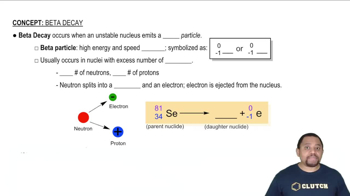Here are the essential concepts you must grasp in order to answer the question correctly.
Nuclear Reactions
Nuclear reactions involve changes in an atom's nucleus, resulting in the transformation of one element into another. These reactions can include processes such as alpha decay, beta decay, and gamma emission. Understanding the type of nuclear reaction is crucial for predicting the products formed, as different reactions follow specific rules regarding particle conservation and transformation.
Recommended video:
Beta Decay
Beta decay is a type of radioactive decay in which a neutron in the nucleus is transformed into a proton, emitting a beta particle (an electron or positron) in the process. This transformation increases the atomic number of the element by one while keeping the mass number unchanged. Recognizing beta decay is essential for completing nuclear equations, as it directly influences the identity of the resulting nuclide.
Recommended video:
Conservation of Nucleons
In nuclear reactions, the conservation of nucleons (protons and neutrons) must be maintained. This principle states that the total number of nucleons before and after the reaction must remain constant. When filling in missing particles in a nuclear equation, it is important to ensure that the sum of the atomic numbers and mass numbers on both sides of the equation is equal, reflecting this conservation law.
Recommended video:
Law of Conservation of Mass
 Verified step by step guidance
Verified step by step guidance


